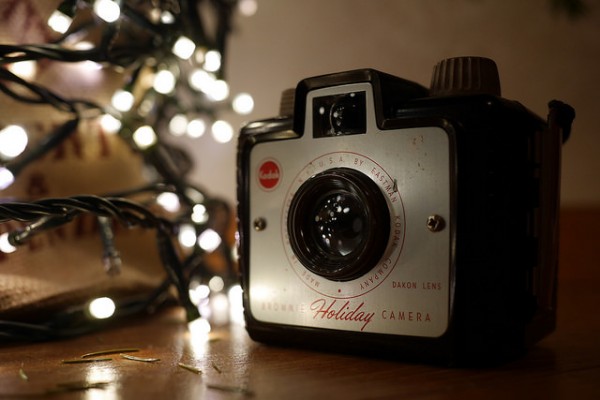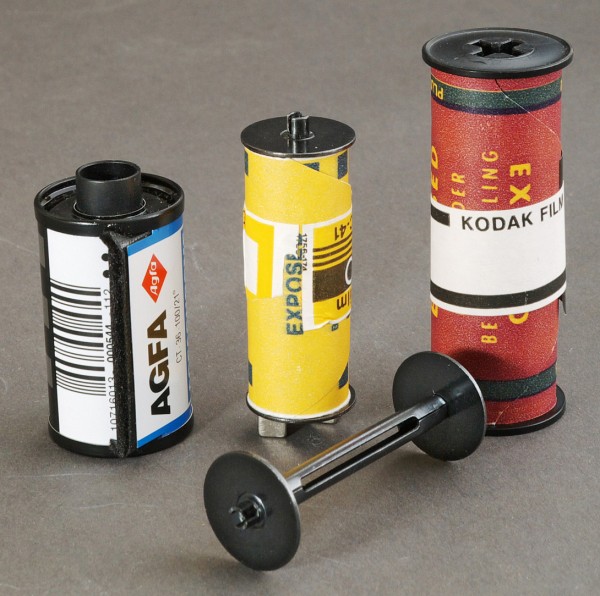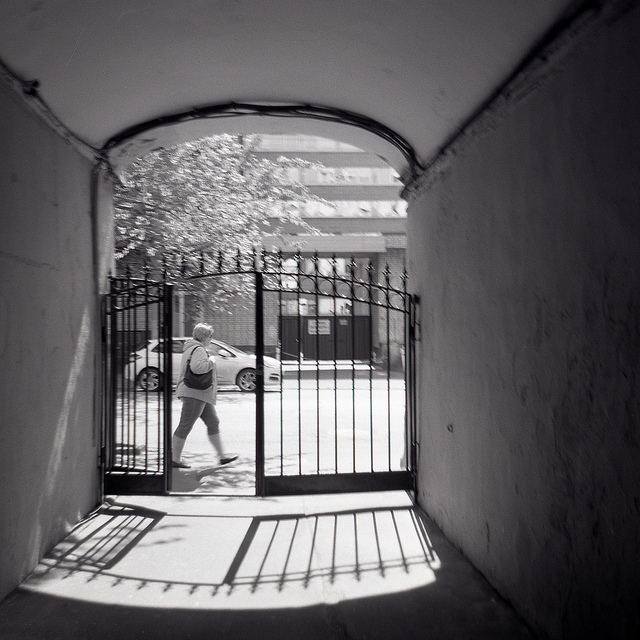Format 127: film that does not exist
Film photographers are strange people. None of them is able to answer the question “Why are you filming?” So that everyone understands and does not have any additional questions. They start to carry something about “warm colors”, “tasty grains” and so on, but in fact we (yes, I am also a film photographer) just like all this fuss with tapes, retro cameras, solutions and red lamps. My case is a special gravity - I photograph on a 127-format film.
It all started with the fact that for the new year I was presented with a Kodak Brownie Holiday bakelite camera of about 1947…

Since there are exactly two and a half moving parts in it (including the rewinding mechanism and the shutter), it turned out to be fully operational - there is simply nothing to break there. I disappeared for a long time on the Internet and found out that the Eastman Kodak company, the ancestor of all household photography, produced a huge number of very different cameras, among which was the Star series. After World War II, designer Arthur Krepsi came to the company, who, possessing great talent, created excellent cameras Starmite, Starmeter, Starmatic and so on.
')

These were simple plastic devices with a single lens and an elementary shutter; with a single shutter speed and one or two aperture values. Their simplicity was promoted by the company, as a competitive advantage - “brought and removed”. The film after that could be mailed to one of the Kodak factories and get an envelope with ready prints. With prices ranging from a dollar to five, these cameras were wildly popular, they were literally in every American home. Today's prices have risen only slightly, on eBay you can find any for about $ 15-20. The reason is that no one needs them. This allowed me to assemble the entire Star line and put it on the shelf. The most favorite is the Starflash camera, it was released in four colors. There was another version, red and white, with the logo of Coca-cola, but it is so rare that it costs up to half a thousand American rubles.

It is clear that just collecting is not interesting - it is necessary to shoot! And here difficulties arose, initially seemingly insurmountable. The fact is that all these soap dishes were filmed on a 127-format film, which today is not produced at all. Occasionally, some small companies announce the start of production, but, failing to find demand, they quickly curtail the initiative.

Everyone knows what “ordinary” photographic film is - its width is 35 mm, there is a double-sided perforation, this format is called “135”, in the photo it is leftmost. This film can be safely bought in the few remaining photo shops. A less popular film format 120 - the so-called "wide", because its width is 62 mm. Perforation no. It is produced in coils, onto which it is wound together with protective opaque paper (“tape”), and is used in special cameras. In the photo she is on the far right. She, too, can be bought, though not in every photo shop. But the main thing is that both formats are still produced. And in the center we see “neither fish nor meat” - a film of format 127. Its width is 46 mm, there is no perforation, there is a leader. And it is impossible to find it for sale to an ordinary person. Totally. For there is no production.
And here photographic ingenuity comes to the rescue. A 46 mm wide film can be made from a wider one, which is still produced, its width is 62 mm - you just need to cut off the excess. There are several ways to do this. The easiest - using the guillotine for cigars.

You need to insert a film roll into it and cut off the excess in full darkness.

This method did not suit me - firstly, it is quite difficult, and secondly, it is easy to miss with the size. The second way is to purchase a special cutter.

To date, it produces its only one little man, bending for him such a price that it becomes sad. In general, after some thought, I decided to make the cutter myself - from three plastic cards, four bolts and a broken piece of blade.

So that my hobby colleagues understand how to use it, I made a special video. Of course, in the video used layout, not a single film during the shooting has not suffered.
There is a pleasant moment: on the old film, which is no longer available, 12 square 4 × 4 cm frames were placed. The film, cut from the new 120, is longer and you can make as many as 17 frames on it. It remains to charge the resulting video in the camera, click it off and show it. Here are examples of photos taken by Starflash:



It is clear that the simplicity of the design of the camera affects the quality of the picture, but as an amusing experiment, this is all very pleased. By the way, in cameras bought on eBay there is often a forgotten film taken in the 1950s. I also show it and sometimes discover photos:


But under the film format 127 produced not only "soap box". There were quite serious devices, for example Yashica 44, Primo Jr, Minolta Miniflex or even Rolleiflex Baby:

Here they are, my beauties. These are two-lens reflex cameras. At that time, the mechanism of the moving mirror, which is now used in all the SLRs, was not yet invented, and therefore a simple and rather insane way to show a picture as close as possible to the one on the film was invented: built a second lens, identical to the first, but without the shutter and aperture. That is, sighting occurs through the top lens, and exposure through the bottom one. Since here both the optics and the mechanics are much more complicated than in all the previous versions, the results of these “two-eyes” are as follows:







By the way, all the time I was very bothered that a narrow piece of film remaining after the cutter had to be thrown away. Until it dawned once: 62 mm - 46 mm = 16 mm. But there are cameras in the world for which these same 16 mm is the native format! For the experiments, a battered “Kiev-30” was bought, and the results turned out to be quite decent. But this, as they say, is another story .

It all started with the fact that for the new year I was presented with a Kodak Brownie Holiday bakelite camera of about 1947…

Since there are exactly two and a half moving parts in it (including the rewinding mechanism and the shutter), it turned out to be fully operational - there is simply nothing to break there. I disappeared for a long time on the Internet and found out that the Eastman Kodak company, the ancestor of all household photography, produced a huge number of very different cameras, among which was the Star series. After World War II, designer Arthur Krepsi came to the company, who, possessing great talent, created excellent cameras Starmite, Starmeter, Starmatic and so on.
')

These were simple plastic devices with a single lens and an elementary shutter; with a single shutter speed and one or two aperture values. Their simplicity was promoted by the company, as a competitive advantage - “brought and removed”. The film after that could be mailed to one of the Kodak factories and get an envelope with ready prints. With prices ranging from a dollar to five, these cameras were wildly popular, they were literally in every American home. Today's prices have risen only slightly, on eBay you can find any for about $ 15-20. The reason is that no one needs them. This allowed me to assemble the entire Star line and put it on the shelf. The most favorite is the Starflash camera, it was released in four colors. There was another version, red and white, with the logo of Coca-cola, but it is so rare that it costs up to half a thousand American rubles.

It is clear that just collecting is not interesting - it is necessary to shoot! And here difficulties arose, initially seemingly insurmountable. The fact is that all these soap dishes were filmed on a 127-format film, which today is not produced at all. Occasionally, some small companies announce the start of production, but, failing to find demand, they quickly curtail the initiative.

Everyone knows what “ordinary” photographic film is - its width is 35 mm, there is a double-sided perforation, this format is called “135”, in the photo it is leftmost. This film can be safely bought in the few remaining photo shops. A less popular film format 120 - the so-called "wide", because its width is 62 mm. Perforation no. It is produced in coils, onto which it is wound together with protective opaque paper (“tape”), and is used in special cameras. In the photo she is on the far right. She, too, can be bought, though not in every photo shop. But the main thing is that both formats are still produced. And in the center we see “neither fish nor meat” - a film of format 127. Its width is 46 mm, there is no perforation, there is a leader. And it is impossible to find it for sale to an ordinary person. Totally. For there is no production.
And here photographic ingenuity comes to the rescue. A 46 mm wide film can be made from a wider one, which is still produced, its width is 62 mm - you just need to cut off the excess. There are several ways to do this. The easiest - using the guillotine for cigars.

You need to insert a film roll into it and cut off the excess in full darkness.

This method did not suit me - firstly, it is quite difficult, and secondly, it is easy to miss with the size. The second way is to purchase a special cutter.

To date, it produces its only one little man, bending for him such a price that it becomes sad. In general, after some thought, I decided to make the cutter myself - from three plastic cards, four bolts and a broken piece of blade.

So that my hobby colleagues understand how to use it, I made a special video. Of course, in the video used layout, not a single film during the shooting has not suffered.
There is a pleasant moment: on the old film, which is no longer available, 12 square 4 × 4 cm frames were placed. The film, cut from the new 120, is longer and you can make as many as 17 frames on it. It remains to charge the resulting video in the camera, click it off and show it. Here are examples of photos taken by Starflash:



It is clear that the simplicity of the design of the camera affects the quality of the picture, but as an amusing experiment, this is all very pleased. By the way, in cameras bought on eBay there is often a forgotten film taken in the 1950s. I also show it and sometimes discover photos:


But under the film format 127 produced not only "soap box". There were quite serious devices, for example Yashica 44, Primo Jr, Minolta Miniflex or even Rolleiflex Baby:

Here they are, my beauties. These are two-lens reflex cameras. At that time, the mechanism of the moving mirror, which is now used in all the SLRs, was not yet invented, and therefore a simple and rather insane way to show a picture as close as possible to the one on the film was invented: built a second lens, identical to the first, but without the shutter and aperture. That is, sighting occurs through the top lens, and exposure through the bottom one. Since here both the optics and the mechanics are much more complicated than in all the previous versions, the results of these “two-eyes” are as follows:







By the way, all the time I was very bothered that a narrow piece of film remaining after the cutter had to be thrown away. Until it dawned once: 62 mm - 46 mm = 16 mm. But there are cameras in the world for which these same 16 mm is the native format! For the experiments, a battered “Kiev-30” was bought, and the results turned out to be quite decent. But this, as they say, is another story .

Source: https://habr.com/ru/post/398505/
All Articles